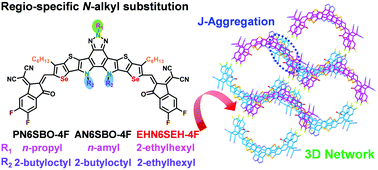Regiospecific N-alkyl substitution tunes the molecular packing of high-performance non-fullerene acceptors†
Abstract
The rapid development of non-fullerene acceptors (NFAs) with strong near-infrared absorption has led to remarkably enhanced short-circuit current density (Jsc) values in organic solar cells (OSCs). NFAs based on the benzotriazole (Bz) fused-ring π-core have great potential in delivering both high Jsc and decent open-circuit voltage values due to their strong intramolecular charge transfer with reasonably low energy loss. In this work, we have designed and synthesized a series of Bz-based NFAs, PN6SBO-4F, AN6SBO-4F and EHN6SEH-4F, via regiospecific N-alkyl engineering based on the high-performance NFA mBzS-4F that was reported previously. The molecular packing of mBzS-4F, AN6SBO-4F, and EHN6SEH-4F single crystals was analyzed using X-ray crystallography in order to provide a comprehensive understanding of the correlation between the molecular structure, the charge-transporting properties, and the solar cell performance. Compared with the typical honeycomb single-crystal structure of Y6 derivatives, these NFAs exhibit distinctly different molecular packing patterns. The strong interactions of terminal indanone groups in mBzS-4F and the J-aggregate-like packing in EHN6SEH-4F lead to the formation of ordered 3D networks in single-crystals with channels for efficient charge transport. Consequently, OSCs based on mBzS-4F and EHN6SEH-4F show efficient photon-to-current conversions, achieving the highest power conversion efficiency of 17.48% with a Jsc of 28.83 mA cm−2.

- This article is part of the themed collections: Materials Horizons 2022 Most Popular Articles, 2023 Materials Horizons Lunar New Year collection and Special issue in honour of Seth Marder


 Please wait while we load your content...
Please wait while we load your content...